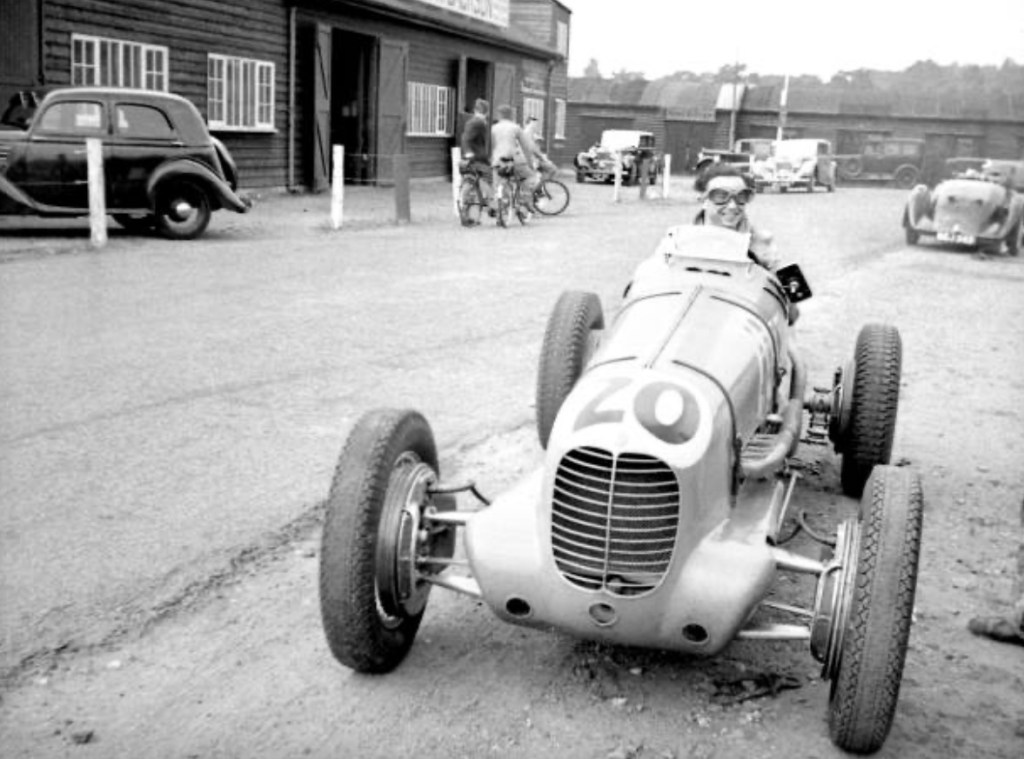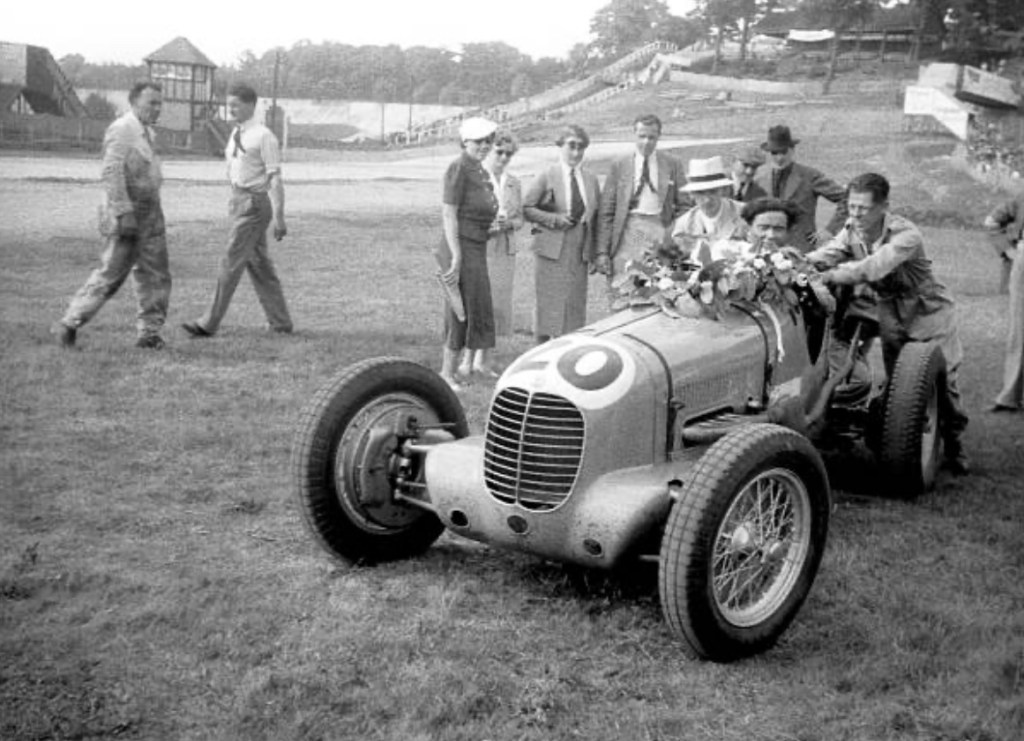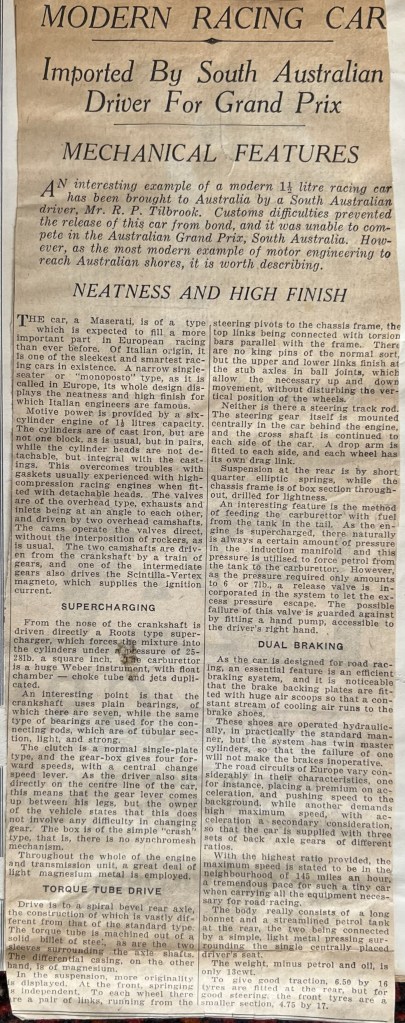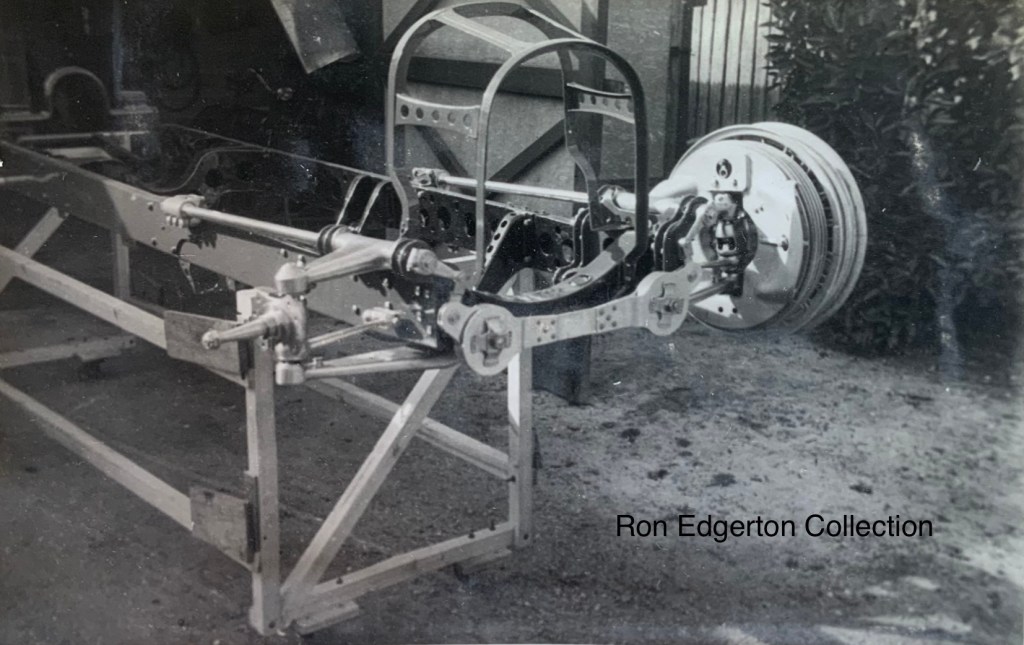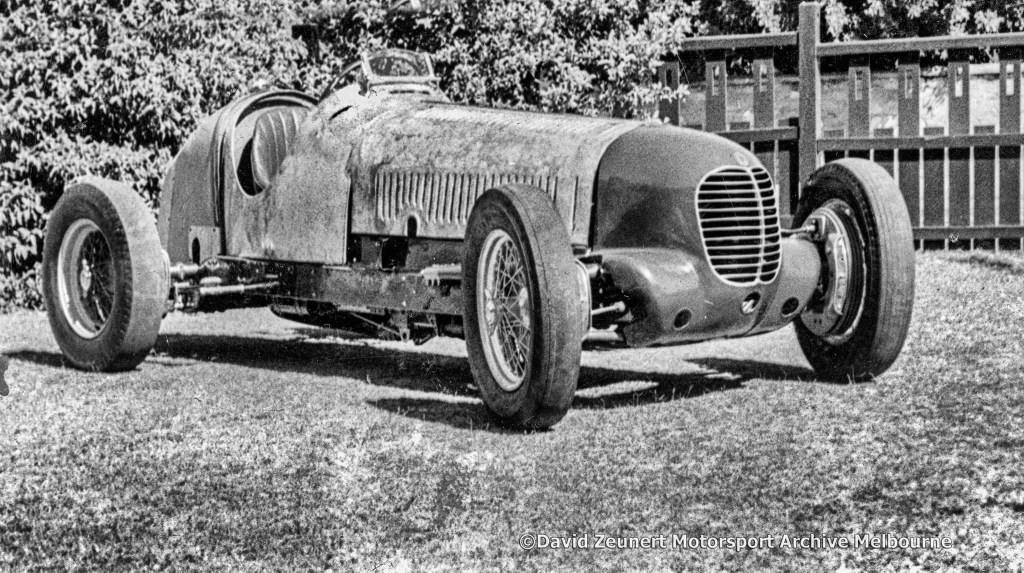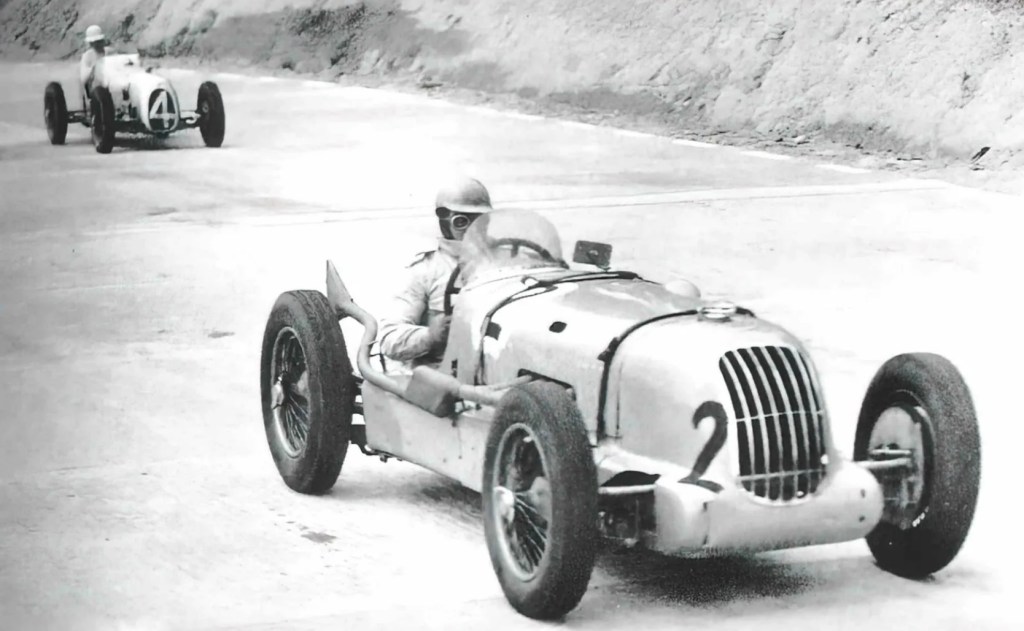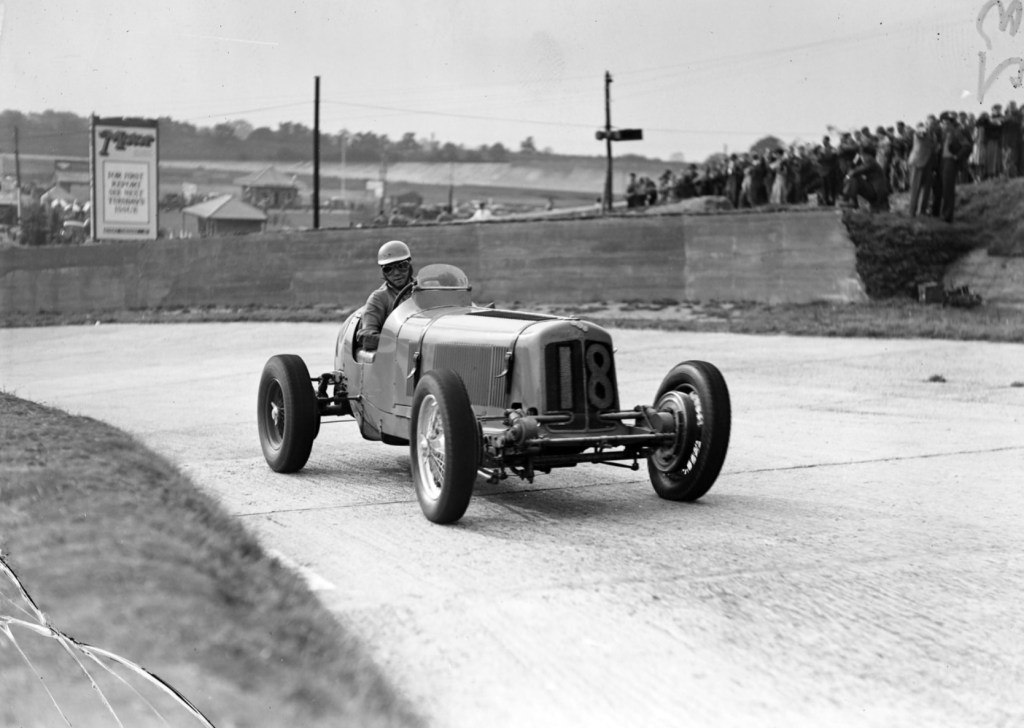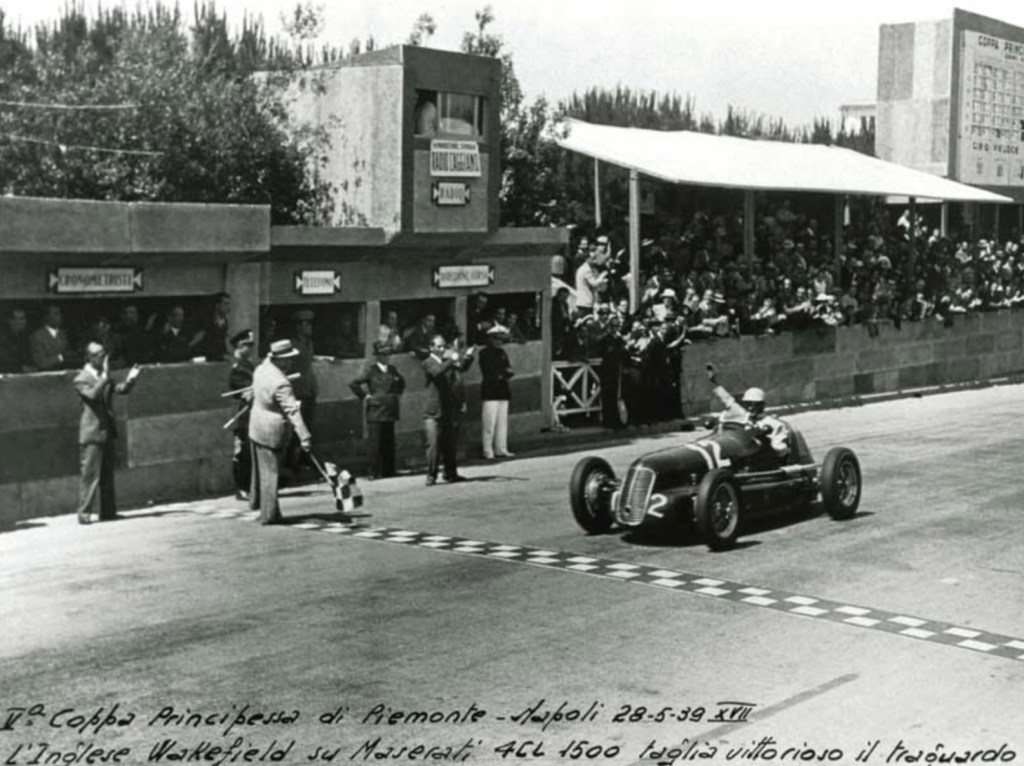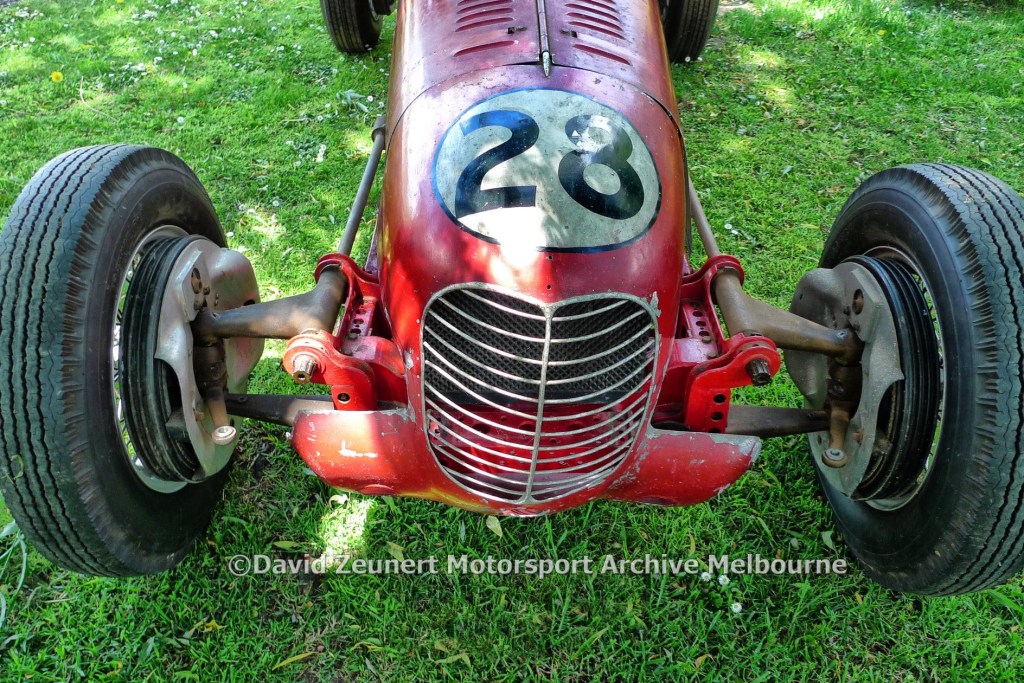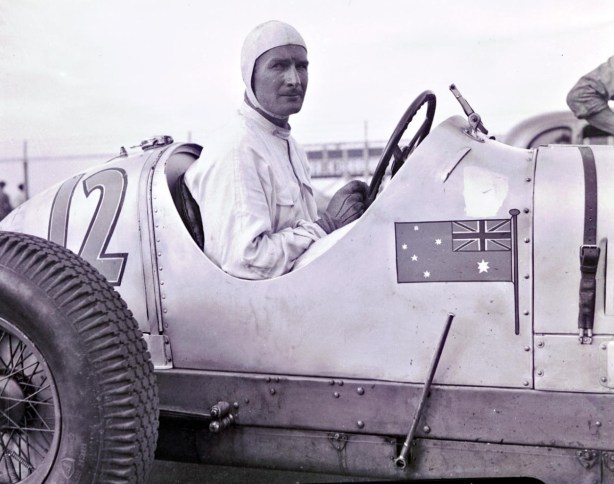
Freddy McEvoy, aka ‘Suicide Freddy’ and ‘Tiger’ to the babes he charmed, was a ladies man, adventurer and friend of fellow Australian and screen star Errol Flynn. He was an accomplished car racer, an Olympic medallist and World Champion on the ice, a sailor, gambler, suspected Nazi agent and a whole lot more…
Here the intrepid Australian is aboard his Maserati 6CM prior to the start of the 1936 Vanderbilt Cup, Roosevelt Raceway, Westbury, Long Island, New York on 12 October.
Frederick Joseph McEvoy was born in Melbourne’s inner southern suburb of St Kilda on February 12, 1907 and moved to England with his mother when he was 10. Educated at the famous Jesuit boarding school Stonyhurst College in Lancashire, his later professions seemingly included jewellery design, public relations consultant, yacht dealer and perhaps arms and contraband trader- he admitted later in life to being a rogue, swindler and a conman who used his intelligence and charm to mix with the upper echelons of society.
Said to have generously proportioned wedding-tackle by a number of his mounts, he reputedly also knew how to use said equipment. As a consequence of his looks, physical attributes and line of chat Freddy cut a swathe through the ladies with various sources crediting him as also running a team of gigolos who kept the bored ladies of the south of France entertained in a manner which put smiles permanently upon their faces.
Exactly how he ratcheted himself up the totem pole of life is not entirely clear but Freddy’s journey took him from partying with a young Errol Flynn in Melbourne/Sydney to wild times with the great and the good in England and onto the French Riviera in its golden years pre-war.
The Australian ‘Truth’ newspaper, the tabloid perhaps more aptly titled ‘Lies’, has it in 1948 that McEvoy was the scion of a prominent Sydney family who went abroad with his mother and brother as youngsters when she took them to Switzerland for the winter sports season. He soon became popular with the international sporting set and was well known for his bob-sledding prowess.
Another 1951 Truth report records that Freddy (Frederick signed his own name in short-form as Freddy not ‘Freddie’ as is practically the case in any reference source one views) was virtually unknown when he first hit Europe in the 1930’s. He was then in his early twenties and arrived with his widowed mother and ailing brother Theodore. ‘…Gradually the young man with the film star smile, bronzed figure and quick Irish-Australian turn of wit began to be noticed’.
Of the relationship with Flynn, Truth reports that Freddy and Errol were close friends back in the 1920’s in Melbourne when both worked with the Dalgety wool enterprises business- a huge national company at the time.
Whatever the case, Freddy figured out that easy money was to be made through the legs of the idle-rich becoming an adept lover, diver, boxer, racer, skier and bobsled competitor where he was a familiar sight at some of the more fashionable European resorts of the day ‘plying his trade’.
Max-Everist Phillips writes that ‘Bobsleigh competitors of the 1930’s prided themselves on three inter-related pursuits: dangerous sports, daring women and dubious money. McEvoy’s skills at the first facilitated his success with the second, who usually provided the third’…
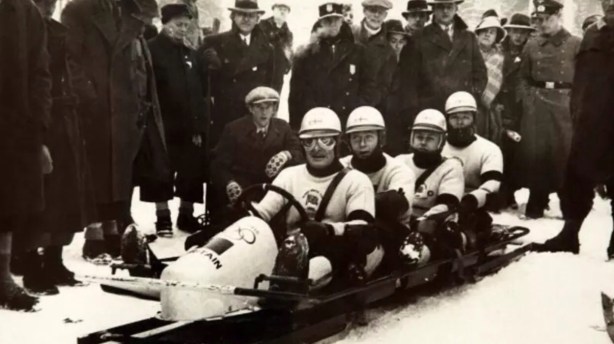
Before the 1936 Winter Olympics, (above) where he was a member of the British team, McEvoy had proved his daring and speed as a tobogganist on the famous, dangerous Cresta Run at St Moritz, Switzerland- he was awarded the ‘Cresta Colours’ that year for his accomplishments.
Keen to compete at the highest level he would not have been eligible to represent Australia through the Australian Olympic Federation, as there was no State or National governing body for tobogganing or bobsleigh in Australia at the time- in fact there was no sport of skiing at the time to speak of!
Without wanting to give a dissertation on the development of skiing in Australia, the first moves on skis are thought to have been carried out by Norwegian gold-miners at Kiandra in the New South Wales Alps during the long winter of 1861. The first ski-lift was built near Mount Beauty in Victoria in 1936 but in simple terms the Alpine areas of Tasmania, Victoria and New South Wales were not developed as ski-fields until post-war when European migrants, some of whom worked on the Snowy Mountains Scheme (a massive post-war twenty year hydro-power generation and irrigation scheme- one of the ‘engineering wonders of the world) saw the potential of the Australian Alps and made formative investments at places like Thredbo and Perisher Valley. The sport itself did not boom until the seventies with baby boomers looking for activities a bit more sophisticated than those which were available to, or could be afforded by many of their parents.
‘It is quite likely that he (McEvoy) associated with British bobsledders in Switzerland and was, as a British subject, eligible to compete for the mother country. It would have been difficult for the British authorities to overlook his nomination or prowess’ the Sydney Morning Herald reported.
Freddy was accorded the highest team honour by the British Olympic Committee to carry the British flag at the opening ceremony of the 1936 Games- that does amuse me, an Aussie carrying the flag for the Brits on such an august occasion!
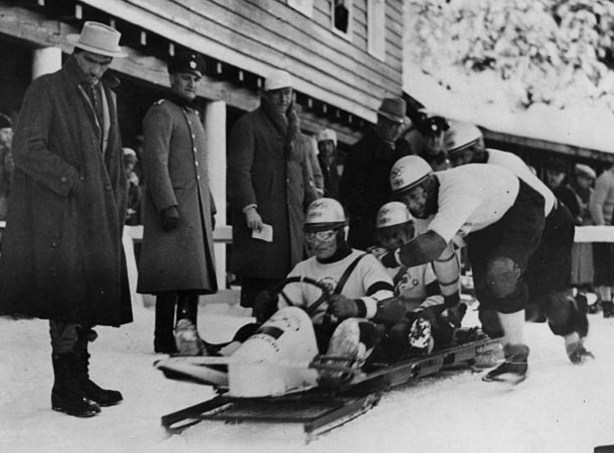
Freddy, captain and steering, British 4 man bob, Garmisch Olympics 1936 (Getty)
Freddy and his team took the bronze medal with four runs down the treacherous bobsled course, finishing behind two Swiss combinations in front of a crowd of about 32,000 people. ‘Suicide Freddy’ was pipped for a medal in the two-man bob, finishing fourth with Garmisch-Partenkirchen well known for its bobsled run on which several men had died. Freddy wasn’t the only motor racer contesting events on the Olympic ice, GP racer Count ‘Tonino’ Brivio was eleventh in the the two-man bob and tenth in the four-man.
Bad weather limited training on the course before the Olympic race and crews had only two or three days’ practice on the fast and difficult run with ‘Britain fortunate to have an experienced and daring driver to steer both the four- and two-man bobs’, the British Teams post event report said.
One of the great bobsledders of the time, Bill Fiske of the US, wrote: ‘Freddie McEvoy has invented one of the most lethal toboggans ever seen on the run. He had a toboggan constructed of hollow ground runners…tremendously fast on a straight course but impossible to manoeuvre around corners…’
McEvoy proved after the 1936 Olympics that he was no flash in the pan. He was second in the Curzon Cup on Cresta in 1937, won the world two-man bob championship at Cortina, Italy in 1937 and the world four-man bob at St Moritz in the same year. He retained the four-man title in 1938 and was runner-up in 1939.
Clearly 1936 was a busy year for the enterprising Australian who was said to have won $25,000 playing backgammon in Monte Carlo and then spent the money the next day on a new Maserati.
In fact the 6CM Maser Voiturette he bought, chassis # 1535 was the first such machine to have been sold to a privateer, Maserati’s new Voiturette model first appeared in March 1936.
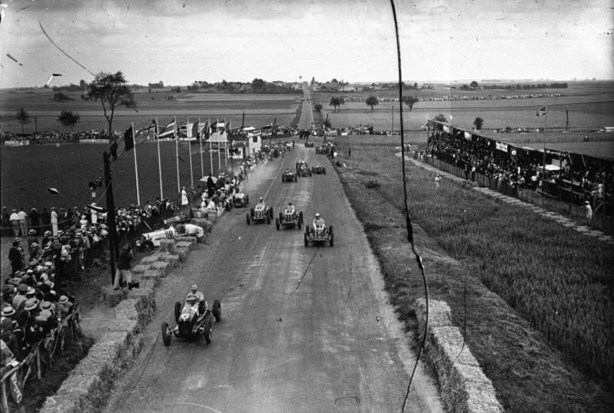
GP Picardie. #6 Carlo Trossi Maser 6CM, #2/#44/#14 B Bira, Earl Howe and Patrick Fairfield on ERA Type B, Type B and Type A (unattributed)
Freddy first entered his new six-cylinder, DOHC, supercharged 155bhp machine in the Grand Prix de Picardie held at Peronne in mid June 1936.
In a splendid display he was fourth in both his heat and in the final won by Dick Seaman’s Delage- in a year of dominance in Voiturette racing which carried the talented Englishman into the Mercedes Benz Grand Prix team.
John Medley wrote of the race ‘…On a scorching hot day the two heats saw the demise of Raymond Mays’ extremely quick ERA and also that of Arthur Dobson, with wins to Trossi and a surprisingly much slower Dick Seaman. Lehoux’ works ERA failed on the line in the final, which was led by Fairfield, an off-song Maserati of Trossi, and Bira’s ERA, before Bira moved past Trossi, with Seaman next until his steering (thought to have been damaged in an earlier Nurburgring incident) failed and the Delage hit a wall in the little village of Brie. The same corner in Brie momentarily claimed Fairfield’s ERA from a stern battle with Bira, so the little Siamese Prince won again from Fairfield and Lord Howe in ERA’s and McEvoy’s distant Maserati. There were no other finishers’.
Getting a little ahead of ourselves, Freddy’s Voiturette season commenced during the Monaco GP weekend, the Aussie contested the ‘Coupe Prince Rainier’ on Saturday 11 April in an earlier Maserati 4CM on the same weekend in which the new 6CM made its race debut.
McEvoy started from grid 14, with Earl Howe on pole in an ERA Type B and ran well until lap 43 when he spun on oil left by Zehender’s Maser 6CM and hit a wall damaging the cars fuel tank. This meeting was the first at which 6CM’s raced- Scuderia Torino entered a car for Rovere, with Zehender relieving him in the 6CM late in the race. McEvoy ran as high as eighth, the race was won by B Bira in an ERA Type B who ‘…took the chequered flag to take the first victory of his career, winning possibly the most prestigious voiturette race of the year only 392 days after making his race debut in a Riley Imp at Brooklands’ according to kolumbus.f1.
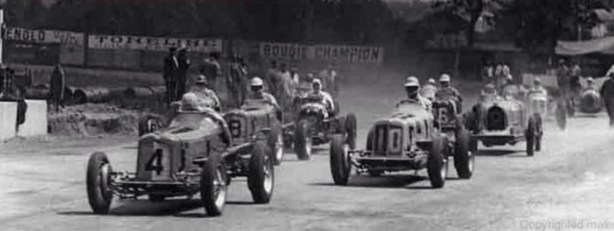
Albi GP. #4 Marcel Lehoux ERA Type B, #8 Patrick Fairfield ERA Type B, #10 Bira again B Type ERA with #26 the nose of McEvoy’s Maser 6 CM (unattributed)
At the Albi GP in mid-July Freddy was ejected from his car in spectacular fashion during the first heat. The car caught fire after rolling across the straw bales opposite the pits, the car then burned furiously. Aggregate results of the two heats gave the win to Bira from Pierre Veyron and Hans Reusch in ERA Type B, Bugatti T51A and Maserati 4CS respectively.
The Coppa Ciano was held at Livorno in early August on a new course through the town rather than the usual mountain layout used hitherto, Trossi won in a works 6CM with Freddy eighth 2 minutes behind the leader.
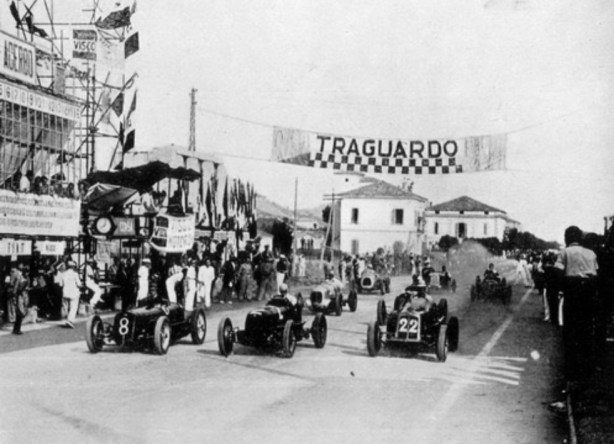
Coppa Acerbo. #8 Dick Seaman Delage 15S8, #2 Carlo Trossi Maser 6CM and #22 Bira ERA Type B (unattributed)
On the daunting Pescara road circuit on the Adriatic Coast in mid-August he was a strong fourth in the Coppa Acerbo having started fifth on the grid with Seaman again taking a Delage win.
In a busy month, in late August, the Berne GP was conducted on the Bremgarten road course in Switzerland. Freddy was seventh from grid ten in a chassis MotorSport said ‘…was the most dangerous Maserati, an independently sprung Maserati which should have done well’.
Freddy, far from the most experienced driver on these grids was clearly no dilettante behind the wheel however many attractions and distractions there were sitting seductively on his pit counter. It does make you wonder what McEvoy could have achieved had he focused on his racing, but such was his zest for living life to the full that this was never the case. Wine, women and song sounds pretty good to me all the same.
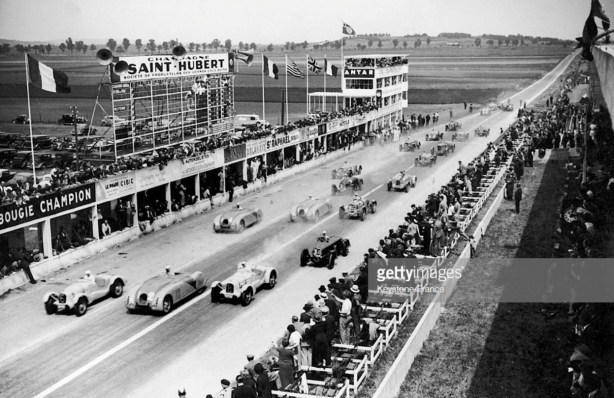
Marne GP 1936, the growth of French sportscar racing as a response to the success of the Nazi funded German teams is an interesting story in itself. #6 Rene Dreyfus and #8 Andre Marcel Talbot T150C split #12 Jean-Pierre Wimille Bugatti T57G- the similar Bugs of Robert Benoist and Pierre Veyron on the row behind. #34 and #26 the Michel Paris and Laury Schell Delahaye 135CS. The Paris car is the 135CS shortly thereafter imported to Australia and raced by John Snow- and to an AGP win at Leyburn, Queensland in John Crouch’s hands in 1949. McEvoy’s Jag 100SS way back in the pack (Keystone)
In the middle of the year on July 5 Freddy also contested the sportscar Marne GP at Reims in a 2.5 litre Jaguar SS100.
He brought the ponderous beast home fifteenth overall and first in the 2-3 litre class, the patriotic MotorSport proclaiming an ‘S.S Wins A Continental Race’- they credit the race to Frank McEvoy, an error rather than another nickname. John Medley ‘…Fast Freddy McEvoy, almost lived up to his other nickname ‘Suicide Freddy’ as he grappled with its nose-heavy understeer which flicked to alarming oversteer on exit to every corner on the very fast Reims-Gueux Circuit. Playing what MotorSport called ‘a waiting game’ (when actually he was travelling as fast as he dared) a long way behind the winning Bugattis which were chased by Talbots and Delahayes, brave Freddy brought the car home for a class win…’
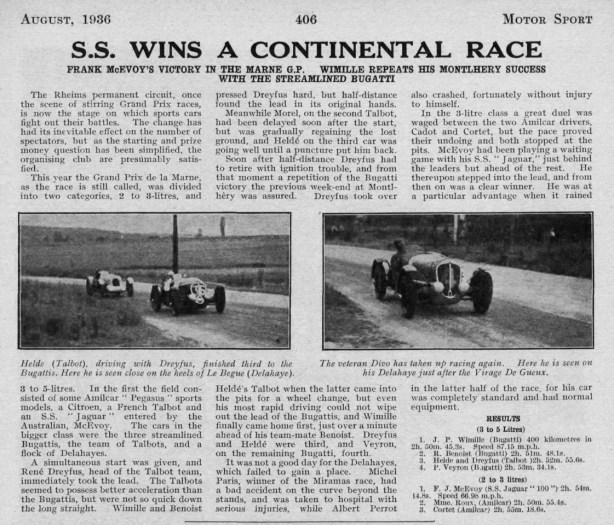
It would be intriguing to know exactly when McEvoy first raced, his cv included the blue-riband sportscar Mille Miglia in 1935, it was certainly the first major race he contested. In that classic test of driver and car he shared a Vittorio Jano designed Alfa Romeo 6C1750 with Ghersi, the pair failing to finish the race won by another memorable Alfa, the 8C 2900B raced by the Pintacuda/Della Stufa crew.
In October 1936 Freddy was well enough funded by his various enterprises and acquaintances to contest the Vanderbilt Cup Races on New York’s Long Island, representing Australia in the 6CM.
This was an amazing event held on a very expensive facility by the standards of the day built by the Vanderbilt family and several associates including Indy winner Eddie Rickenbacker. It seems the designers of the track, who lived on opposite sides of the country, failed to communicate so the track ‘comprised a single 3775 foot straightaway and sixteen completely unbanked corners, ten of which are best described as hairpins.’
A huge purse attracted some of Europe’s best teams, the race was a real endurance affair, 75 laps of a tight 4 mile road course circuit- 300 miles in total. Tazio Nuvolari won aboard an Alfa Romeo 12C-36 in 4 hours 32.44 from Jean-Pierre Wimille’s Bugatti T59 and Antonio Brizio’s Alfa 12C-36- in sixth place was Freddy proving his endurance on the hot day driving the 6CM, his time 4:57.24. Mind you, Carlo Felice-Trossi co-drove the 6CM, how many laps each of the intrepid pilots raced is undisclosed.
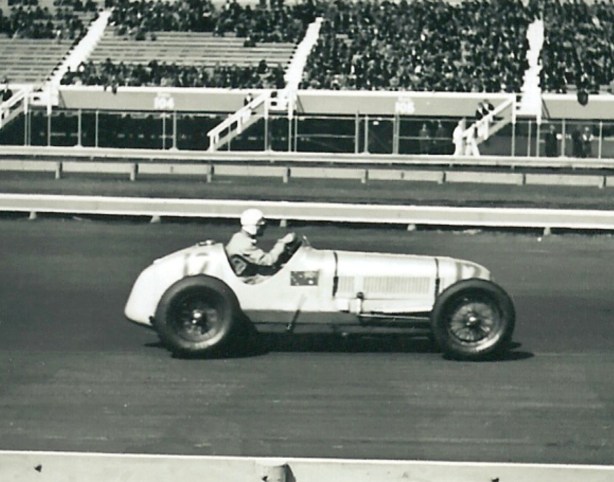
Freddy McEvoy with the Australian flag on the side of his Maser 6CM, Vanderbilt Cup 1936 (VDC)

Vanderbilt Cup start 1936, ID of cars welcome (VDC)

McEvoy Maser on one of the more open corners on a course dominated by tight corners (VDC)
McEvoy’s activities after 1936 are really beyond the scope of this article but he continued to compete at the highest levels of bobsleigh racing, this is covered at the end of the article.
In 1937 he won $10,000 for setting a record time between Paris and Nice of 9 hours 45 minutes in a Talbot-Lago T150C-SS coupe- he was the first person to do the trip from the capital to the Riviera in less than ten hours aboad the 4 litre, six-cylinder OHV, 170 bhp machine.
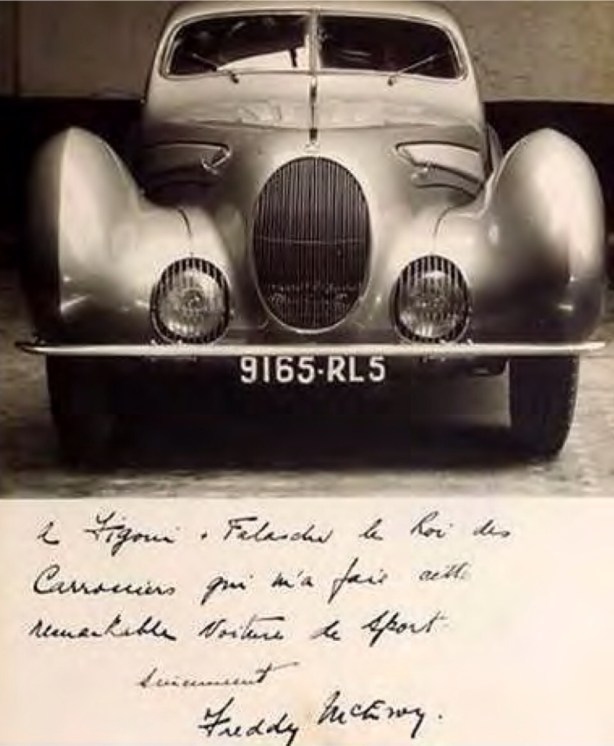
McEvoy’s personal note of thanks for the use of the Talbot makes clear the spelling of the short form of his name (unattributed)
As war broke out the Australian was reluctant to apply his undoubted bravery to the war effort and left Britain to continue his playboy lifestyle on the French Riviera and later New York and Hollywood. His fisticuffs it seems were limited to the odd scrap with husbands of ladies who were miffed by his attention to women who succumbed to his considerable charm.
Freddy shared a house with the by then notorious Errol Flynn in Hollywood and they enjoyed many adventures, including diving expeditions to Mexico. McEvoy was a key witness for Flynn in his infamous statutory rape case in 1942-43- this involved allegations of under-age sex by seventeen year Betty Hansen. Said events purportedly took place in McEvoy’s Bel Air home- his ‘no-nookie here matey’ protestations helped the actor get off the charges. Flynn credited McEvoy in assisting him recover from a growing dependency on opium by burning the actors stash of the drug, their friendship survived the fight which ensued when Flynn realised his drug syringes were ablaze in an adjoining room.
The actor, quoted in Mike Seth-Smith’s book on the Cresta Run, says: ‘I found that he complemented me. He was an athlete, a roisterer like myself, and he could be canny too, very. He had his eye for the main chance and bluntly told me he intended to marry wealth. With his physique and appearance and his charm and culture I didn’t doubt he could do this.’
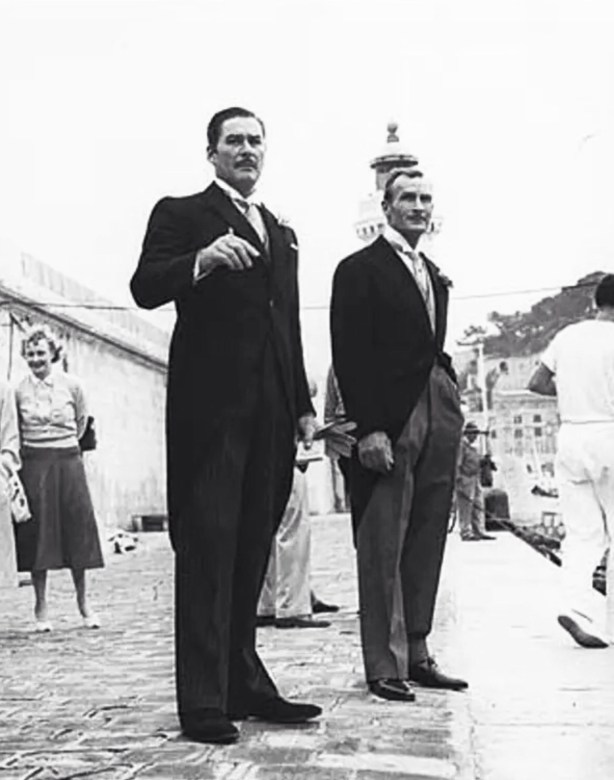
Flynn and McEvoy at Monte Carlo in 1950 just prior to Flynn’s marriage to Patrice Wymore. Freddy was best man and Claude Stephanie Filatre, McEvoys third wife, the other witness (unattributed)
Suspected as spies in the 1930’s, the US authorities monitored the activities of both Flynn and McEvoy with the FBI eventually concluding Freddy was ‘an international pimp who is interested in his own well being and probably not engaged in activities detrimental to the interests of the country’. In the same period, 1944, it is said the hustler smuggled guns, jewellery and alcohol from Mexico City to California on his boat, as his second marriage did not yield much cash.
McEvoy scandalised high society and fascinated the readership of gossip columns in equal measure. ‘A debonair socialite, he courted infamy as one of Hollywood’s self-styled ‘Hellfire Club’ or ‘Three Musketeers’ along with Errol Flynn and Bruce Cabot of ‘King Kong fame’ and was usually characterised by newspapers as a ‘handsome gigolo’ or ‘popular playboy’- the big ‘dame hunter’ married three times.
At one society party in Cannes, the already married McEvoy made a play for Woolworth’s heiress, Barbara Hutton, just divorced from Cary Grant. They never wed but lived together for a time at a ski resort Hutton bought in Franconia, New Hampshire. In a sidebar to this liasion, our intrepid racer was beaten up by some thugs who set up the initial meeting between McEvoy and Hutton after Freddie failed to pay the ‘facilitation fee’! I guess ‘Tinder’ always existed in one form or another whatever the technologies of the day.
Although he failed there, Freddy succeeded in wooing the heiress to an oil fortune, Beatrice Cartwright of the Pratt Family/Standard Oil in 1940. At 63, she was 30 years older than McEvoy and promised him a yacht and a million dollars. McEvoy got the yacht, the 65-tonne Black Swan, but the money never found its way into his bank account. He later married a second heiress, Irene Wrightsman, at 18 years old less than half his age but they drifted apart after Irene’s father removed her access to the families loot.
McEvoy’s third and final wife was Claude Stephanie Filatre, a French fashion model. They married in 1949 and made their home aboard a 104-foot ketch/schooner called Kangaroo or Black Joke depending upon the account you choose to reference- and there are plenty of conflicting accounts about many aspects of this mans life as I hope I have made clear.
The boat struck a reef off the Moroccan coast 60 miles from Casablanca during a storm off North Africa in 1951. There is some speculation that McEvoy was running arms or grog between his home port of Cannes and Tangiers. He made it to the shore and sought help unsuccessfully from a small settlement at Safi. Freddy returned to the floundering boat to rescue Filatre, but this time his luck ran out. McEvoy’s body, naked and scalped was in a lagoon/washed up on the beach on November 9, 1951 and his wife’s body the next day.
It transpires that one of the ships crew was wanted for murder of a prostitute in Berlin in 1945, that man, Manfred Lentner was later convicted of the murder in a Salzburg court in May 1954. Further, at the time of the ‘shipwreck’ British Intelligence had been tracking McEvoy as a suspected arms-dealer and smuggler of contraband between Tangiers and France- so to the very end of the racers story there was plenty of mystery and intrigue including fifteen thousand pounds worth of diamonds and whisky onboard the ship. A French court convened in Morocco found a verdict of murder by persons unknown of McEvoy, Filatre, her maid and three sailors- no-one was ever charged.
Fast Freddy, at best an elite level sportsman and likeable scallywag but perhaps more accurately described as an outstanding sportsman and amoral crook and scumbag certainly did not die guessing about the possibilities of life- without doubt he lived it to the full.
Put more delicately ‘Sport was but one aspect, albeit perhaps the only honourable one, of his fourty-four years on earth. His reputation was variously as an unprincipled playboy, suspected spy, alleged smuggler, dubious adventurer and unhealthy close associate of one of Hollywood’s most iconic but least reputable stars. He was one of the few Australians about whom the standard phrase in obituaries, ‘he led life to the full’ is an understatement’ wrote Max Everest-Phillips.
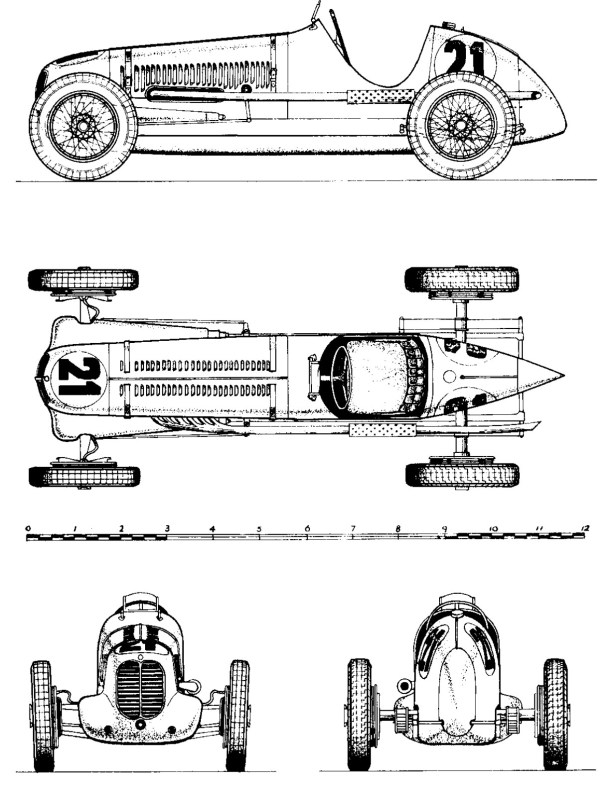 Maserati 6CM…
Maserati 6CM…
‘Voiturettes’, cars of smaller capacity than machines of the contemporary Grand Prix formula went back to the dawn of motor racing, but the class grew in importance with the introduction of the 750 kg formula. There had been no official capacity limit since 1926, although the Voiturette class was usually for cars of 1100cc. During the 1930’s the category was increasingly held for machines of 1500cc- it was attractive to smaller teams and privateers given the growing expense of GP racing. To that end Maserati introduced the 4CM-1500cc 4 cylinder in 1932, with the 6CM a response to the Riley based ERA’s pace, these first raced from 1934.
The 6CM chassis was the usual channel section of the day but heavily boxed as Maserati were beginning to realise the importance of chassis rigidity. Front suspension was similar to the very unsuccessful V8RI GP car with independent suspension by unequal length wishbones and friction dampers up the front. At the rear, a rigid axle was deployed suspended on semi-elliptic springs. The body of the car was similar to the V8RI with a cowled radiator and neat streamlining.
The Fiat parts bin provided quite a few bits including the steering box and gearbox. The ‘tranny was a 4 speeder designed for use in the Fiat Tipo 522 taxi and was considerably overstressed given the cab had a paltry 34bhp. There were plenty of gearbox dramas until Masers started to make their own ‘boxes. The rear axle was made by Isotta Fraschini.
The heart of the matter was a six-cylinder engine of 1493cc which had the cylinders cast in pairs, and twin overhead camshafts driven from the nose of the crank in established Maser practice. A single Weber carb, Roots type blower, Scintilla magneto and dry sump lubrication completed the key mechanical specifications. The neat little motor was claimed to produce 155bhp @ 6200 rpm early on which rose to circa 175bhp over time.
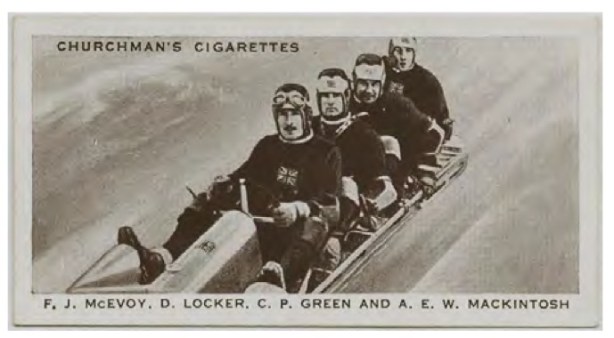
Cigarette card honouring the 1938 4-man bob world championship winning British team with Freddy up front
Freddy’s Alpine Career in Perspective…
Freddy was one of the great sportsmen of his era and in bobsleigh racing one of that discipline’s all-time greats.
He was a pioneer of a sport which was then very dangerous, the medal he won at Garmisch in the ’36 Olympics made him the first Australian to win a Winter Olympics medal albeit representing the mother-country, England.
Over the next three years captaining the British team and piloting the bobsleigh he won two world championships on the trot- in 1937 and 1938, that later year beating ‘the master race’ in front of their home crowd in Nazi Germany. He took silver the year after that.
In total he won three Gold and two silver World Championship medals in two different forms of the sport- the four and two man ‘bobs, and was the first ever competitor, (along with his partner in the two-man bob) to win gold in both events in the same year. He set one last course record in 1939, covering the 1554 metres of the Italian World Championships run at Cortina d’Ampezzo in a time of 1 minute 20.75 seconds. It was also in Cortina where he won his first World Championship gold in the two-man bob in 1937.
It was only the outbreak of war which put an end to his short career- he was the only sportsman from Australia to receive a medal in any of the five founding sports of the Winter Olympics.
Max Everist-Phillip’s, Director of the United Nations Development Programme’s Global Centre in Singapore in a 2015 ‘Numismatic Association of Australia’ article entitled ‘Bobsleigh in a Warm Climate: Pre-war Australian Identity on The Slide’ goes as far as to say that ‘…McEvoy’s 1938 bobsleigh triumph (World Championship Gold) in Nazi Germany represents not just an Australian achievement in an unusual sport from a different era. In the run up to World War 2, the success of the Australian-British team carried political significance. It marked a triumph for the democratic ideal over the Third Reich’s totalitarian ideology and the ‘master race’. Its win offered a psychological boost to the British Empire in the lead up to World War 2. Nazi propaganda sought to claim the German people trained in the body in the service of the state and so international sporting success supposedly demonstrated the might of the ‘new Germany’, thereby apparently justifying its claim for ‘Lebensraum’ and racial supremacy. The victory gripped the popular imagination increasingly interested in the sport’.
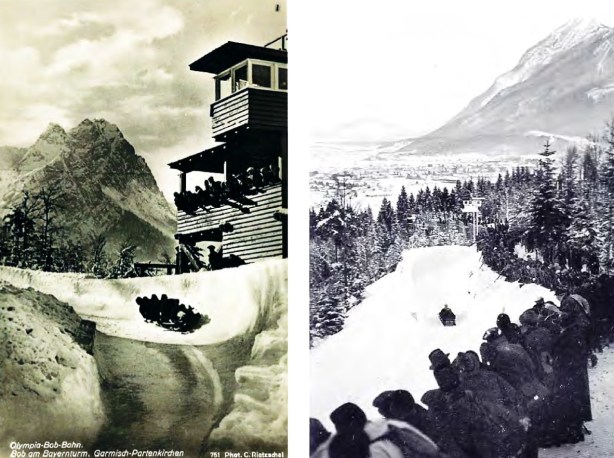
Spectators on a bend and the finishing section of the bobsleigh run, Garmisch, 1936 Olympics
Bibliography…
’Maserati: A Racing History’ Anthony Pritchard, ‘John Snow: Classic Motor Racer’ John Medley, kolumbus.f1, MotorSport magazine, Journal of The Numismatic Society of Australia article ‘Bobsleigh in a Warm Climate: Pre-War Australian Identity on The Slide’ by Max Everest-Phillips, barchetta.cc
Photo Credits…
Getty Images, vanderbiltcupraces.com
Tailpiece: Thank Your Lucky Stars…
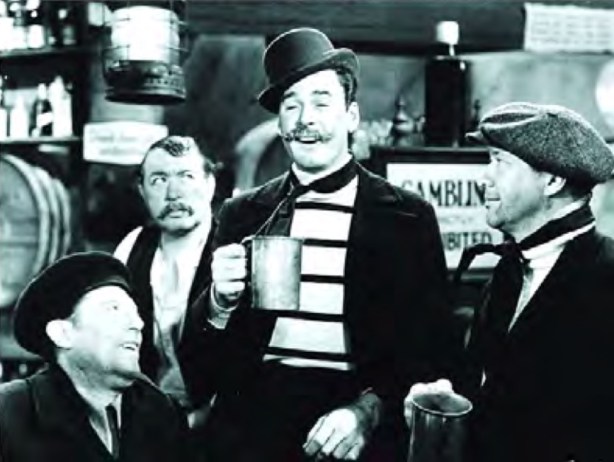
Errol Flynn in the scene from ‘Thank Your Lucky Stars’ in which McEvoy, although unattributed in the credits, appears at right (unattributed)
Finito…


